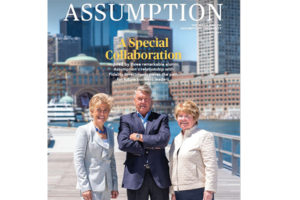
A Bold, Innovative Strategic Plan Will Guide the University into the Future at a Landmark Moment
Since being founded by the Augustinians of the Assumption in 1904, Assumption University has been “refounded” many times, evolving to meet the changing needs of students and the world beyond its campus while remaining true to its Catholic mission.
For instance, on June 14, 1918, the institution, originally conceived as a high school for young French-speaking immigrants, conferred its first baccalaureate degrees. President Francesco Cesareo, Ph.D., sees a certain symmetry in this.
“Assumption was authorized to confer baccalaureate degrees by the governor of Massachusetts in February 1917. During the 1917–18 academic year, Assumption offered a four-year college curriculum for the first time in the midst of the Spanish flu pandemic,” he noted, “and became a University in 2020 during the COVID-19 pandemic.”
A lot has happened since Assumption first opened its doors, requiring the institution to both meet new challenges and remain true to the original vision of its founders. The new strategic plan was created to reflect St. Augustine of Hippo’s journey of self-discovery, a rich inspiration for Assumption in its mission to educate in the tradition of Catholic liberal education. Upon completing his journey of restless reflection, Augustine discovered what he was seeking all along: “Late have I loved you, beauty ever ancient, ever new!” (Confessions, Book X)
Like Augustine, Assumption has embarked upon its own journey of exploration since its founding and has had the foresight and courage to “refound” itself at critical junctures. During the two world wars, for example, the school had to manage severely curtailed enrollment and operate on a shoestring budget, given that Assumption was then an institution for only male students. Many of the faculty members were French-speaking priests who returned to France to minister to troops, posing an additional challenge. Assumption refounded itself yet again in the 1950s, this time from being an institution where all classes were taught in French to offering bilingual education. Not long after that, the curriculum switched completely to English.
A decade later, Assumption faced another crossroads in deciding whether to become a coeducational institution. When women were admitted in 1969, “that was an especially important moment of refounding,” President Cesareo said.
In the early 1970s, Assumption began expanding its offerings beyond the liberal arts to explore the possibility of more professionally oriented programs like business, while striving to maintain “the essence” of an Assumption education as one grounded in the tradition of Catholic liberal education.
On June 10, 2020, Assumption College officially became Assumption University – a landmark moment in the institution’s then-116-year history that sparked another refounding. University status reflects the evolution and growth of Assumption after the institution was restructured into five separate schools, expanded its graduate degree offerings, established a campus in Rome, and significantly broadened the undergraduate academic catalog.
Though much has changed educationally, physically, and structurally at Assumption, the fundamental principles of Assumption’s mission remain the same. The University’s newest strategic plan, Ever Ancient, Ever New: Refounding Assumption, reflects the collective ideas of the University’s community as Assumption charts a courageous, innovative path forward that is true to the institution’s soul and identity, while taking full advantage of new opportunities as a University.
Though the strategic plan has clearly defined goals, President Cesareo described it as “a living document,” one that is never static. He pointed out that the newest strategic plan had already outlined ways in which the institution might deliver education in creative ways by using the most current technologies. While nobody could have anticipated the unprecedented challenges posed by a global pandemic, the University had already begun to consider how to implement remote teaching and learning in a way that would be distinctively Assumption. “Now we can step back and reflect once again on the essence of an Assumption education, and think about how we can continue integrating technology with in-person instruction to benefit teaching and learning as we move into the future,” he said. “The strategic plan was created with the understanding that Assumption will always be responsive as an institution, constantly adapting to changing times and the needs of our community.”
Strategic Plan Focus Areas
Ever Ancient, Ever New: Refounding Assumption articulates an ambitious vision for Assumption University with five main focus areas:
- MISSION
Strengthen the articulation, integration, and engagement of the shared educational mission across every area of the University. - STUDENT SUCCESS & ENGAGEMENT
Foster a culture of student success to promote student satisfaction and engagement. - PROGRAM INNOVATION
Foster innovation and excellence in academic and student programs. - ENHANCE ENROLLMENT
Enhance enrollment through strategic recruitment reflective of mission and market conditions. - FINANCIAL SUSTAINABILITY & CAREFUL STEWARDSHIP
Ensure the financial sustainability of the institution through careful stewardship of assets and the growth/diversification of revenue streams.
For more information on the Universityʼs strategic plan, visit assumption.edu/refounding-assumption.


